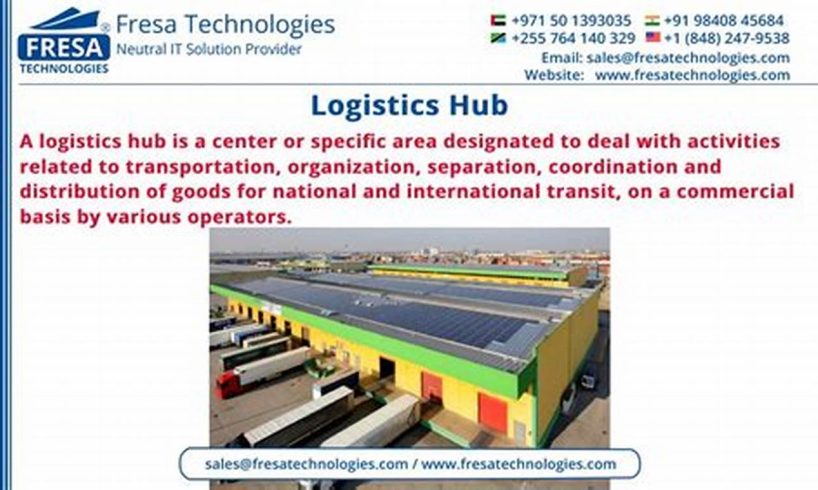
A logistical hub is a physical center that facilitates the storage, handling, and distribution of goods. These hubs serve as central points for the consolidation, break-bulk, and transshipment of cargo, allowing for efficient movement of goods between different locations.
Logistical hubs offer several key benefits, including reduced transportation costs, improved inventory management, and faster delivery times. They also play a crucial role in enhancing supply chain visibility and enabling just-in-time inventory practices. Historically, logistical hubs have been located at strategic points along trade routes, such as major ports, airports, and rail yards.
In recent years, the concept of logistical hubs has evolved with the advent of e-commerce and the rise of global supply chains. Today, logistical hubs are increasingly located near major population centers to facilitate the rapid and cost-effective distribution of goods to consumers. The continued growth of e-commerce is expected to drive further investment in logistical hubs, making them even more critical to the efficient functioning of global supply chains.
1. Centralization
Centralization is a key aspect of logistical hub definition, as it highlights the central role that logistical hubs play in the consolidation and distribution of goods. This centralization offers several advantages, including:
- Reduced transportation costs: By consolidating shipments at a central point, logistical hubs can reduce transportation costs by optimizing routes and leveraging economies of scale.
- Improved inventory management: Centralization allows for better inventory management, as goods can be stored and managed at a single location, reducing the risk of stockouts and overstocking.
- Faster delivery times: Logistical hubs can improve delivery times by providing a central point for the distribution of goods, reducing the distance that goods need to travel to reach their final destination.
- Increased efficiency: Centralization enables more efficient movement of goods, as it reduces the need for multiple shipments and allows for better coordination of transportation and distribution activities.
Overall, the centralization of logistical hubs is essential for the efficient and cost-effective storage, handling, and distribution of goods. It provides a central point for the consolidation and distribution of goods, offering numerous benefits to businesses and consumers alike.
2. Efficiency
The efficient movement of goods between different locations is a crucial aspect of logistical hub definition, as it highlights the role of logistical hubs in facilitating the smooth and cost-effective flow of goods throughout supply chains.
- Centralized operations: Logistical hubs act as central points for the consolidation and distribution of goods, enabling efficient movement by reducing the need for multiple shipments and optimizing transportation routes.
- Multimodal connectivity: Logistical hubs often offer multimodal connectivity, allowing for the seamless transfer of goods between different modes of transportation, such as road, rail, air, and water, ensuring efficient movement across long distances.
- Technology integration: Logistical hubs leverage technology to enhance efficiency, such as automated warehousing systems, inventory management systems, and transportation management systems, which optimize operations and reduce transit times.
- Strategic location: Logistical hubs are typically located at strategic points along trade routes or near major population centers, enabling efficient distribution of goods to their intended destinations, reducing transportation times and costs.
In summary, the efficient movement of goods between different locations is a key aspect of logistical hub definition, as it underpins the ability of logistical hubs to facilitate the smooth and cost-effective flow of goods throughout supply chains, connecting suppliers, manufacturers, distributors, and consumers.
3. Cost-effectiveness
The cost-effectiveness of logistical hubs is a crucial component of their definition, as it highlights their ability to reduce transportation costs and improve supply chain efficiency. By consolidating shipments at central locations, logistical hubs offer several key benefits that contribute to their cost-effectiveness:
- Reduced shipping costs: Consolidating shipments allows logistical hubs to negotiate better shipping rates with carriers due to increased volume, resulting in lower transportation costs for businesses.
- Optimized transportation routes: Logistical hubs can optimize transportation routes by combining multiple shipments into larger, more efficient loads, reducing the number of shipments and the distance traveled, which further lowers transportation costs.
- Improved inventory management: Consolidation at logistical hubs enables better inventory management, reducing the risk of overstocking and stockouts, which can lead to significant cost savings.
- Increased efficiency: By consolidating shipments, logistical hubs can streamline transportation and distribution processes, reducing handling costs and improving overall operational efficiency.
In summary, the cost-effectiveness of logistical hubs is a key aspect of their definition, as it encompasses the various ways in which they reduce transportation costs and enhance supply chain efficiency. Through consolidation, optimization, and improved inventory management, logistical hubs enable businesses to save on shipping costs, optimize transportation routes, and improve overall operational efficiency.
4. Inventory management
Inventory management is a crucial aspect of logistical hub definition, as it highlights their role in optimizing inventory levels and implementing just-in-time inventory practices. Logistical hubs serve as central points for the storage and distribution of goods, enabling businesses to manage their inventory more effectively and efficiently.
- Centralized inventory control: Logistical hubs provide centralized inventory control, allowing businesses to have a clear and real-time view of their inventory levels across multiple locations. This enables better coordination of inventory and reduces the risk of stockouts or overstocking.
- Just-in-time inventory: Logistical hubs facilitate just-in-time inventory practices, where businesses receive inventory only when it is needed for production or distribution. This reduces inventory holding costs and improves cash flow.
- Cross-docking: Logistical hubs enable cross-docking, a practice where goods are received and shipped out without being stored in the warehouse. This reduces inventory dwell time and further improves inventory turnover.
- Inventory visibility: Logistical hubs provide real-time inventory visibility, allowing businesses to track the movement of goods throughout the supply chain. This enhances inventory planning and forecasting, reducing the risk of inventory shortages or surpluses.
In summary, the connection between inventory management and logistical hub definition lies in the ability of logistical hubs to facilitate effective inventory management and just-in-time inventory practices. Through centralized inventory control, cross-docking, and real-time inventory visibility, logistical hubs enable businesses to optimize their inventory levels, reduce inventory costs, and improve supply chain efficiency.
5. Supply chain visibility
In the context of logistical hub definition, supply chain visibility plays a critical role as logistical hubs serve as central points for the consolidation, storage, and distribution of goods, providing greater visibility and traceability throughout the supply chain.
- Real-time tracking: Logistical hubs enable real-time tracking of goods as they move through the supply chain, providing businesses with up-to-date information on the location and status of their inventory.
- Centralized data repository: Logistical hubs act as centralized data repositories, consolidating information from multiple sources, such as suppliers, carriers, and warehouses, to provide a comprehensive view of the supply chain.
- Improved collaboration: Logistical hubs facilitate collaboration among different stakeholders in the supply chain, enabling them to share information and coordinate activities more effectively, enhancing overall visibility.
- Risk management: Enhanced supply chain visibility enables businesses to identify and mitigate potential risks, such as delays, disruptions, and fraud, by providing early warnings and allowing for proactive decision-making.
In conclusion, the connection between supply chain visibility and logistical hub definition lies in the ability of logistical hubs to provide real-time tracking, serve as centralized data repositories, facilitate collaboration, and enable risk management. By enhancing supply chain visibility and traceability, logistical hubs empower businesses with greater control and agility, enabling them to make informed decisions, optimize inventory levels, and respond quickly to changes in demand or disruptions.
6. Strategic location
The strategic location of logistical hubs is a crucial aspect of their definition, as it highlights their placement at advantageous points that facilitate efficient distribution and access to markets.
- Proximity to markets: Logistical hubs are often located near major population centers or consumption hubs, allowing for faster and more cost-effective delivery of goods to end consumers.
- Access to transportation networks: Logistical hubs are typically situated at strategic points along trade routes, providing access to multiple modes of transportation, such as highways, railways, airports, and ports, enabling seamless movement of goods across different regions.
- Intermodal connectivity: Logistical hubs serve as intermodal terminals, where goods can be easily transferred between different modes of transportation, facilitating efficient and cost-effective movement of goods over long distances.
- Reduced transportation costs: The strategic location of logistical hubs allows for the optimization of transportation routes, reducing distances and transit times, which ultimately translates into lower transportation costs for businesses.
In summary, the strategic location of logistical hubs is closely tied to their definition as it underscores their placement at advantageous points that enable efficient distribution, access to markets, intermodal connectivity, and reduced transportation costs. These factors collectively contribute to the effectiveness of logistical hubs in facilitating the smooth flow of goods throughout supply chains.
7. Multimodal connectivity
Multimodal connectivity is a crucial aspect of logistical hub definition, as it highlights the ability of logistical hubs to seamlessly connect different modes of transportation, enabling efficient and cost-effective movement of goods across different regions and continents.
- Intermodal terminals: Logistical hubs often serve as intermodal terminals, allowing for the transfer of goods between different modes of transportation, such as road, rail, air, and water, all within a single location. This intermodal connectivity streamlines the transportation process and reduces transit times.
- Global reach: Multimodal connectivity enables logistical hubs to extend their reach globally, as they can connect to multiple transportation networks and facilitate the movement of goods to and from different parts of the world.
- Reduced transportation costs: By leveraging multiple modes of transportation, logistical hubs can optimize shipping routes and reduce transportation costs for businesses. Intermodal transportation often combines cost-effective modes like rail and water transportation with faster modes like air transportation, resulting in a balance between cost and speed.
- Flexibility and resilience: Multimodal connectivity provides flexibility and resilience to supply chains. In case of disruptions or delays in one mode of transportation, businesses can easily switch to alternative modes, ensuring the uninterrupted flow of goods.
In conclusion, the multimodal connectivity offered by logistical hubs is a key aspect of their definition, as it enables efficient and cost-effective movement of goods across different regions and modes of transportation. This intermodal connectivity streamlines the transportation process, extends global reach, reduces costs, and provides flexibility and resilience to supply chains.
8. Technology integration
Technology integration is a crucial aspect of logistical hub definition, as it highlights the use of advanced technologies to enhance the efficiency and productivity of logistical operations. Logistical hubs leverage various technological solutions to streamline processes, reduce costs, and improve overall supply chain performance.
Automated warehousing systems, for instance, utilize robotics, conveyors, and automated storage and retrieval systems to automate the movement and storage of goods within warehouses. These systems improve accuracy, reduce labor costs, and optimize space utilization. Inventory management systems, on the other hand, provide real-time visibility and control over inventory levels, enabling logistical hubs to maintain optimal stock levels, reduce waste, and improve customer service.
The integration of technology in logistical hubs also extends to transportation management systems, which optimize shipping routes, reduce transportation costs, and provide real-time tracking of goods. Additionally, data analytics and artificial intelligence are increasingly used to analyze vast amounts of data generated by logistical hubs, allowing for predictive analytics, demand forecasting, and improved decision-making.
By leveraging technology, logistical hubs can achieve greater efficiency, reduce operating costs, and enhance the overall quality of their services. The integration of technology is thus a key component of logistical hub definition, as it underpins the ability of logistical hubs to meet the demands of modern supply chains and contribute to the smooth flow of goods.
9. Sustainability
Sustainability is an increasingly important aspect of logistical hub definition, as logistical hubs strive to minimize their environmental impact while meeting the demands of global supply chains.
- Energy efficiency
Logistical hubs are implementing energy-efficient technologies and practices to reduce their carbon footprint. This includes using LED lighting, solar panels, and energy-efficient appliances. Some hubs are also exploring renewable energy sources, such as wind and geothermal, to power their operations. - Waste reduction
Logistical hubs are adopting waste reduction strategies to minimize their environmental impact. This includes recycling programs, waste audits, and the use of sustainable packaging materials. Some hubs are also exploring innovative ways to reuse and repurpose waste materials. - Sustainable transportation
Logistical hubs are promoting sustainable transportation practices to reduce their carbon emissions. This includes using fuel-efficient vehicles, optimizing delivery routes, and exploring alternative fuels, such as electric and hydrogen. Some hubs are also partnering with rail and water transportation providers to reduce their reliance on road transportation. - Employee engagement
Logistical hubs are engaging their employees in sustainability initiatives to foster a culture of environmental responsibility. This includes providing training on sustainable practices, recognizing employee efforts, and rewarding innovative ideas. Employee engagement is crucial for the long-term success of sustainability programs.
By incorporating sustainable practices, logistical hubs can reduce their environmental impact, enhance their reputation, and attract environmentally conscious customers and partners. Sustainability is thus an integral part of logistical hub definition, as it reflects the growing importance of environmental responsibility in the logistics industry.
FAQs on Logistical Hub Definition
Frequently asked questions and their answers provide a deeper understanding of the definition of logistical hubs and their significance in the supply chain industry.
Question 1: What is the primary function of a logistical hub?
Logistical hubs serve as central points for the efficient storage, handling, and distribution of goods. They facilitate the consolidation, break-bulk, and transshipment of cargo, enabling seamless movement of goods between different locations.
Question 2: What are the key benefits of utilizing logistical hubs?
Logistical hubs offer numerous benefits, including reduced transportation costs, improved inventory management, faster delivery times, enhanced supply chain visibility, and increased flexibility and resilience.
Question 3: How do logistical hubs contribute to cost reduction in supply chains?
By consolidating shipments and optimizing transportation routes, logistical hubs reduce transportation costs. They also enable just-in-time inventory practices, minimizing inventory holding costs and improving cash flow.
Question 4: In what ways do logistical hubs enhance supply chain visibility?
Logistical hubs provide real-time tracking of goods, centralized data repositories, and improved collaboration among supply chain stakeholders. This enhanced visibility enables better inventory management, risk mitigation, and informed decision-making.
Question 5: How does the strategic location of logistical hubs impact their effectiveness?
The strategic placement of logistical hubs near major transportation networks, population centers, and consumption hubs allows for faster and more cost-effective distribution of goods to end consumers. It also facilitates intermodal connectivity, enabling seamless transfer of goods between different modes of transportation.
Question 6: What role does technology play in the operations of logistical hubs?
Logistical hubs leverage technology to enhance efficiency and productivity. Automated warehousing systems, inventory management systems, transportation management systems, and data analytics are widely used to optimize operations, reduce costs, and improve overall supply chain performance.
In summary, logistical hubs play a crucial role in modern supply chains, offering a range of benefits that contribute to cost reduction, improved efficiency, increased visibility, and enhanced flexibility. Their strategic location and integration of technology further strengthen their effectiveness in facilitating the seamless movement of goods globally.
Transition to the next article section: The Importance of Logistical Hubs in Global Supply Chains
Tips for Optimizing Logistical Hub Operations
Logistical hubs play a crucial role in the efficiency and effectiveness of global supply chains. By implementing the following tips, businesses and organizations can optimize the operations of their logistical hubs:
Tip 1: Leverage Technology for Automation
Employ automated systems for tasks such as inventory management, order fulfillment, and warehouse operations. This can significantly improve efficiency, reduce labor costs, and minimize errors.
Tip 2: Enhance Inventory Visibility and Control
Implement real-time inventory tracking systems to gain complete visibility into inventory levels across multiple locations. This enables better inventory management, reduces stockouts, and optimizes inventory turnover.
Tip 3: Optimize Transportation and Distribution
Utilize transportation management systems to plan and optimize delivery routes, carrier selection, and load consolidation. This can reduce transportation costs, improve delivery times, and enhance overall supply chain efficiency.
Tip 4: Foster Collaboration and Communication
Establish clear communication channels and collaborative relationships with suppliers, carriers, and other stakeholders. This facilitates seamless information sharing, reduces delays, and improves overall supply chain coordination.
Tip 5: Prioritize Sustainability
Incorporate sustainable practices into logistical hub operations, such as energy-efficient technologies, waste reduction programs, and sustainable packaging materials. This not only reduces environmental impact but also enhances the reputation and customer appeal of the logistical hub.
Summary:
By implementing these tips, logistical hubs can significantly improve their operational efficiency, reduce costs, enhance supply chain visibility, and contribute to a more sustainable and resilient supply chain ecosystem.
Conclusion
In summary, a logistical hub serves as a central point for the efficient storage, handling, and distribution of goods, offering numerous advantages and playing a crucial role in the smooth functioning of global supply chains. By consolidating shipments, optimizing transportation routes, enhancing inventory management, increasing supply chain visibility, and leveraging technology, logistical hubs contribute to cost reduction, improved efficiency, and enhanced flexibility.
As global supply chains continue to evolve, the importance of logistical hubs will only grow. Businesses and organizations must recognize the strategic value of logistical hubs and invest in their development and optimization to gain a competitive edge and meet the demands of the modern marketplace. Embracing innovation, collaboration, and sustainability will be key to unlocking the full potential of logistical hubs and driving supply chain excellence.






